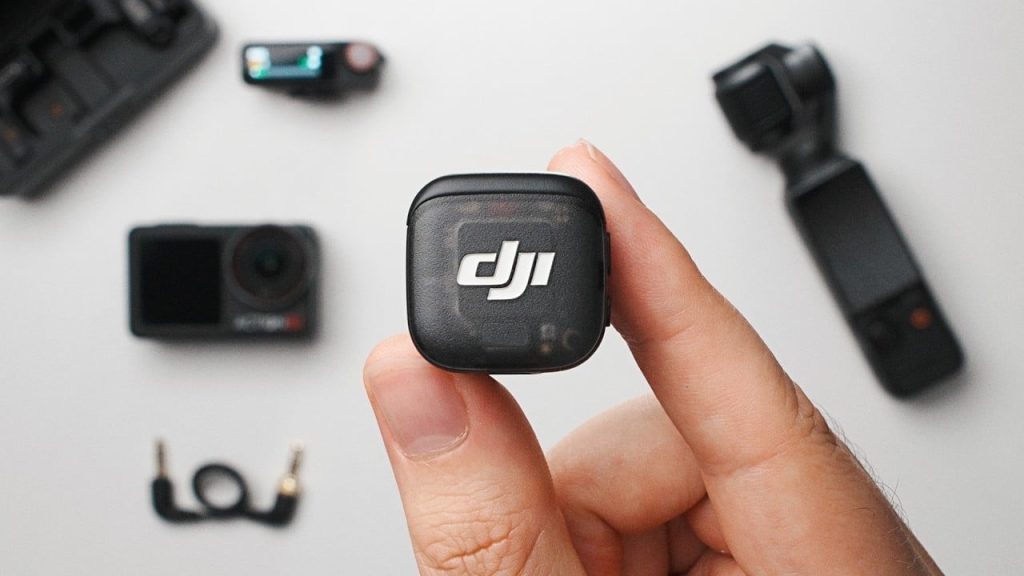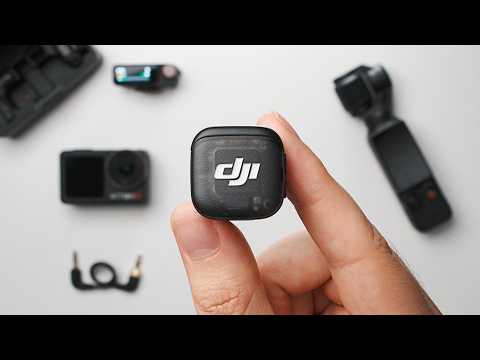Creator Tests DJI Mic 3’s New Features And Finds One Critical Flaw

Think Media has published an in-depth hands-on review of DJI’s new Mic 3 wireless microphone system, praising its compact design and professional features while uncovering a surprising design flaw with the magnetic mount—and offering a simple free fix.
In this video review, the creator walks through the Mic 3’s impressive feature set, from its half-size form factor compared to the Mic 2 to new capabilities like adaptive gain control and improved noise cancellation. But he also discovered that on certain fabrics, the magnetic mount tends to rotate and drift over time, potentially pointing the microphone away from the speaker.

Half the Size, Packed With Pro Features
The reviewer immediately highlights the Mic 3‘s most striking change: it’s approximately half the size of the DJI Mic 2, bringing it closer to the compact Mic Mini while retaining professional features. “It’s about half the size of the DJI Mic 2, closer to the size of the Mic Mini, but still has a ton of pro features crammed into it,” he explains in the video.
The redesigned transmitter features a more matte finish compared to the Mic 2’s shiny, reflective surface. “I think the more matte finish is going to be less distracting, a little bit more discreet, which is nice,” the reviewer notes. The new mounting clip design includes built-in magnets that can be swapped out for different attachment options, providing more flexibility for various shooting scenarios.
One clever mounting trick the creator demonstrates: since the clip fits onto a cold or hot shoe, you can slide it directly onto your camera. “It’s an upgrade to your camera’s internal audio. Or you could flip it around if you are behind the camera. Well, now you have much better audio right behind the camera,” he explains, adding that it also serves as convenient storage when not in use.

Adaptive Gain Control Simplifies Audio Capture
The reviewer emphasizes DJI’s new adaptive gain control feature as a significant workflow improvement. “I think this is where DJI has made a really good effort to make it simple to capture high quality audio without having to constantly tweak or do a lot of post-processing,” he says.
The system offers dynamic mode for balanced voice levels. “You’re currently hearing me on the dynamic setting and this is going to sort of help balance out your voice. So if you’re not sure where to set your volume, just turn the setting on and it will help you get good audio,” he demonstrates during the review.
DJI has also introduced lossless audio transmission for higher quality recording, though the reviewer notes this setting affects the unit’s range. The Mic 3 extends transmission distance from 250 meters (820 feet) to 400 meters (1,312 feet). “No one’s going to really need to use it in that sort of range,” he acknowledges, “but the real benefit is how much better it is in normal shooting conditions. It’s going to be a lot more reliable.”
Testing Noise Cancellation and Voice Presets
The creator conducts real-world tests of the improved active noise cancellation, which offers two levels: basic and strong. In his outdoor test, he cycles through each setting. “Right now it is set to off. And you can hear a little bit of bugs in the background, a little bit of airplane going by,” he notes before enabling basic noise cancellation, then switching to the highest level.
He also tests the three new voice tone presets—regular, rich, and bright. “This is what the rich voice tone preset sounds like. So, a little bit more of the low end might make it sound more like a podcast setup,” he explains. After testing all three, he concludes that “the bright setting works really well when it’s mounted to your chest. I find that you lose a lot of those higher-end frequencies, and switching it over to bright kind of brings some of that back.”
Dual-File 32-Bit Float Recording Adds Flexibility
Building on the Mic 2’s 32-bit float backup recording, the Mic 3 introduces dual-file recording. “We have two different files for every single recording that we make. One is an original kind of raw sort of sound. And the second is an algorithm enhanced audio,” the reviewer explains. This gives creators both a clean file and a processed version without additional post-work.
The 32-bit float capability helps prevent clipping when audio gets loud and allows boosting quiet audio without introducing excessive noise. For professional workflows, the Mic 3 now supports up to four transmitters connected to a single receiver and includes integrated timecode. “This is a massive deal if you’re working with multiple cameras. It keeps everything perfectly in sync without having to clap or line up your audio later,” he emphasizes.
The Trade-Offs: What DJI Removed
The reviewer addresses two significant features DJI eliminated to achieve the smaller size. First, the 3.5mm microphone input is gone. “You can’t plug in a lavalier mic if you want a more discrete setup. Instead, you’re relying solely on the built-in mics,” he explains, asking viewers for their thoughts on whether they’d prefer a slightly larger unit with the input or the current compact form factor.
Second, DJI removed the safety track feature that the Mic 2 and Mic Mini both have, which records two channels at different volumes. “I don’t know. I’d rather have that control of having it in post where I can change things versus I’m kind of just relying on the backup recording feature if something goes wrong,” he says, suggesting DJI could add this back via firmware update.
The Magnetic Mount Flaw and Free Fix
During his full day of testing, the reviewer discovered a design issue. “On certain fabrics, this magnet mount tends to kind of spin around. It kind of rotates. Maybe over time it will casually drift away and suddenly I’m looking down and the microphone is pointed in the wrong direction,” he explains.
His solution? “I think it might be due to the sticker on the back of the transmitter. It’s a little bit slick. So, I actually just peeled mine back in. It’s a little bit gunky, but it actually fixes the problem.” He notes the clip mount has more friction and doesn’t have this rotation issue.
Battery Life and Pricing
The Mic 3 offers eight hours per transmitter and 10 hours for the receiver—an improvement over the Mic 2’s six hours. The charging case extends total runtime to 28 hours. “This is plenty to cover a full day of shooting,” the reviewer confirms after using it throughout a complete production day.
However, he provides context: “If you have the DJI Mic Mini, that actually has a better battery life of up to around 11 hours on each transmitter. Obviously, the Mic 3 has a lot more going on, a lot more features, so it requires a little bit more power.”
At $330 for the full kit with two transmitters and one receiver, the Mic 3 sits in premium territory. “There’s a lot of cheap options. However, I don’t think anything comes quite as capable as what this can do,” he argues. Single transmitters are available for $99, making it an accessible upgrade for Osmo Pocket 3 owners.
Final Verdict From the Field
After extensive testing, the creator sees the Mic 3 as an excellent upgrade for those needing professional features. “If you’re someone who needs great noise cancellation, needs backup 32bit float recording, or just some of these amazing pro features, I generally think that the DJI Mic 3 is an excellent upgrade,” he concludes.
But he acknowledges it’s not for everyone. “I know that there’s quite a few of our audience that just wants a simple microphone to get up and running that has great audio, and I might redirect them towards the DJI Mic Mini. It sounds great, and it’s nearly half the cost.”
DroneXL’s Take
This hands-on review highlights exactly what makes the DJI Mic 3 compelling: DJI successfully miniaturized professional features without compromising audio quality. The creator’s real-world testing reveals both the system’s strengths—particularly the adaptive gain control and improved noise cancellation—and its limitations.
The magnetic mount rotation issue is a legitimate concern that DJI should address, though the reviewer’s peel-the-sticker fix suggests it’s more of a surface friction problem than a fundamental magnetic design flaw. It’s the kind of detail you only discover through extended field use, making this hands-on review particularly valuable.
The removal of the 3.5mm mic input and safety track feature will frustrate some users, but the reviewer’s perspective is sound: most creators using this system will clip it directly to clothing and use the built-in mics. The safety track removal is more puzzling, especially since the Mic Mini has it. A firmware update adding this back would be welcomed by the community.
What’s most valuable about this review is the practical focus on workflow. The creator doesn’t just list specs—he demonstrates how adaptive gain control actually simplifies recording, tests noise cancellation in real outdoor conditions, and shows creative mounting options like using the cold shoe attachment on cameras. These are the insights that help other creators decide if the $330 investment makes sense for their specific shooting style.
For drone pilots specifically, the extended 400-meter range and improved interference handling in crowded RF environments could be significant benefits. The ability to connect up to four transmitters also opens up possibilities for multi-pilot interview scenarios or group discussions about drone operations that were previously challenging to capture cleanly.
What do you think? Share your thoughts in the comments below.
